sensor MERCEDES-BENZ SPRINTER 2006 Service Manual
[x] Cancel search | Manufacturer: MERCEDES-BENZ, Model Year: 2006, Model line: SPRINTER, Model: MERCEDES-BENZ SPRINTER 2006Pages: 2305, PDF Size: 48.12 MB
Page 532 of 2305
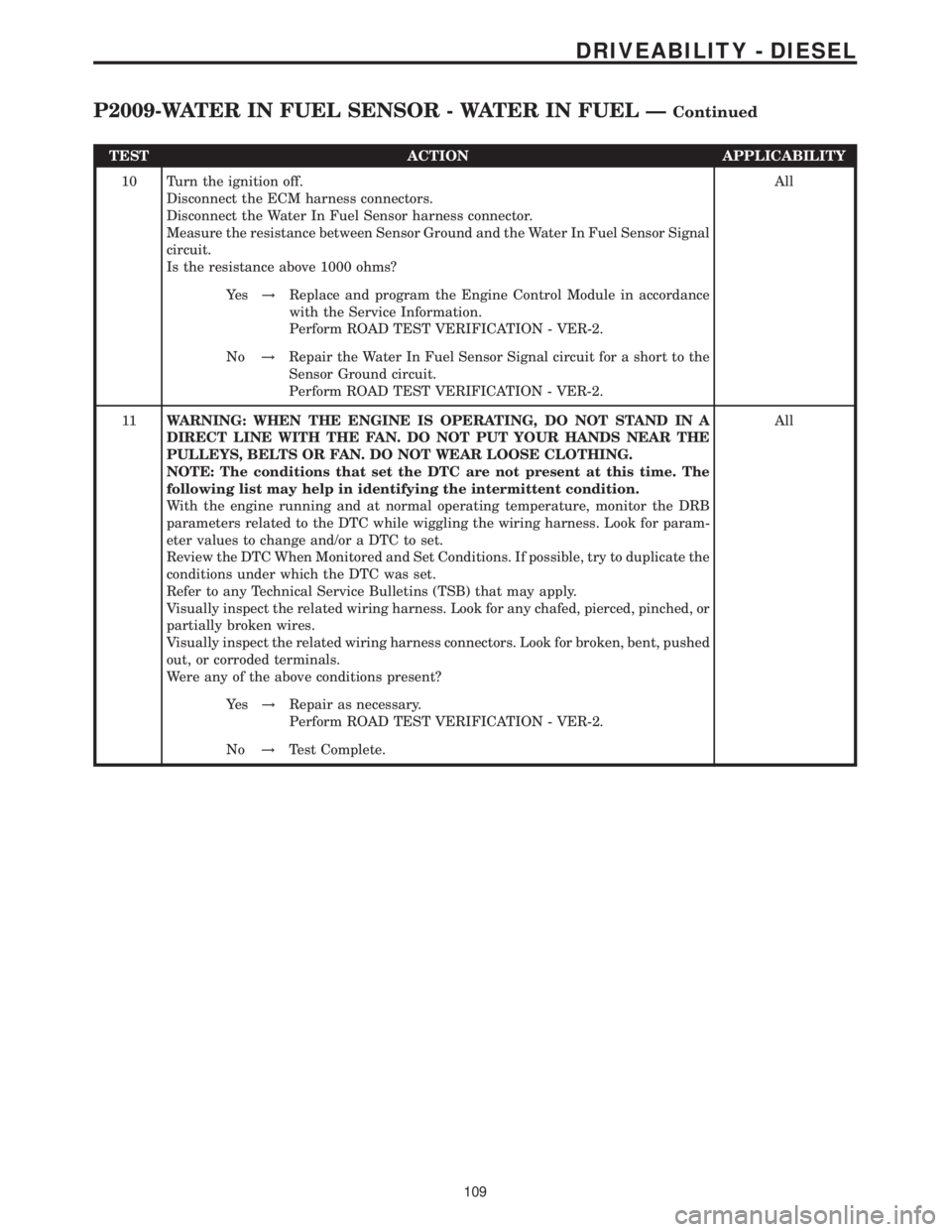
TEST ACTION APPLICABILITY
10 Turn the ignition off.
Disconnect the ECM harness connectors.
Disconnect the Water In Fuel Sensor harness connector.
Measure the resistance between Sensor Ground and the Water In Fuel Sensor Signal
circuit.
Is the resistance above 1000 ohms?All
Ye s!Replace and program the Engine Control Module in accordance
with the Service Information.
Perform ROAD TEST VERIFICATION - VER-2.
No!Repair the Water In Fuel Sensor Signal circuit for a short to the
Sensor Ground circuit.
Perform ROAD TEST VERIFICATION - VER-2.
11WARNING: WHEN THE ENGINE IS OPERATING, DO NOT STAND IN A
DIRECT LINE WITH THE FAN. DO NOT PUT YOUR HANDS NEAR THE
PULLEYS, BELTS OR FAN. DO NOT WEAR LOOSE CLOTHING.
NOTE: The conditions that set the DTC are not present at this time. The
following list may help in identifying the intermittent condition.
With the engine running and at normal operating temperature, monitor the DRB
parameters related to the DTC while wiggling the wiring harness. Look for param-
eter values to change and/or a DTC to set.
Review the DTC When Monitored and Set Conditions. If possible, try to duplicate the
conditions under which the DTC was set.
Refer to any Technical Service Bulletins (TSB) that may apply.
Visually inspect the related wiring harness. Look for any chafed, pierced, pinched, or
partially broken wires.
Visually inspect the related wiring harness connectors. Look for broken, bent, pushed
out, or corroded terminals.
Were any of the above conditions present?All
Ye s!Repair as necessary.
Perform ROAD TEST VERIFICATION - VER-2.
No!Test Complete.
109
DRIVEABILITY - DIESEL
P2009-WATER IN FUEL SENSOR - WATER IN FUEL ÐContinued
Page 533 of 2305

Symptom List:
P2010-MASS AIR FLOW SENSOR NEGATIVE DEVIATION
P2010-MASS AIR FLOW SENSOR POSITIVE DEVIATION
P2068-MASS AIR FLOW SENSOR PLAUSIBILITY SIGNAL RATIO
TOO LARGE
P2068-MASS AIR FLOW SENSOR PLAUSIBILITY SIGNAL RATIO
TOO SMALL
Test Note: All symptoms listed above are diagnosed using the same tests.
The title for the tests will be P2010-MASS AIR FLOW SENSOR
NEGATIVE DEVIATION.
When Monitored and Set Condition:
P2010-MASS AIR FLOW SENSOR NEGATIVE DEVIATION
When Monitored: With the ignition on.
Set Condition: The ECM detects a rationality problem with the MAF Sensor.
P2010-MASS AIR FLOW SENSOR POSITIVE DEVIATION
When Monitored: With the ignition on.
Set Condition: The ECM detects a rationality problem with the MAF Sensor.
P2068-MASS AIR FLOW SENSOR PLAUSIBILITY SIGNAL RATIO TOO LARGE
When Monitored: With the ignition on.
Set Condition: The ECM detects a rationality problem with the MAF Sensor.
P2068-MASS AIR FLOW SENSOR PLAUSIBILITY SIGNAL RATIO TOO SMALL
When Monitored: With the ignition on.
Set Condition: The ECM detects a rationality problem with the MAF Sensor.
POSSIBLE CAUSES
MASS AIRFLOW SENSOR
INTERMITTENT CONDITION
11 0
DRIVEABILITY - DIESEL
Page 534 of 2305
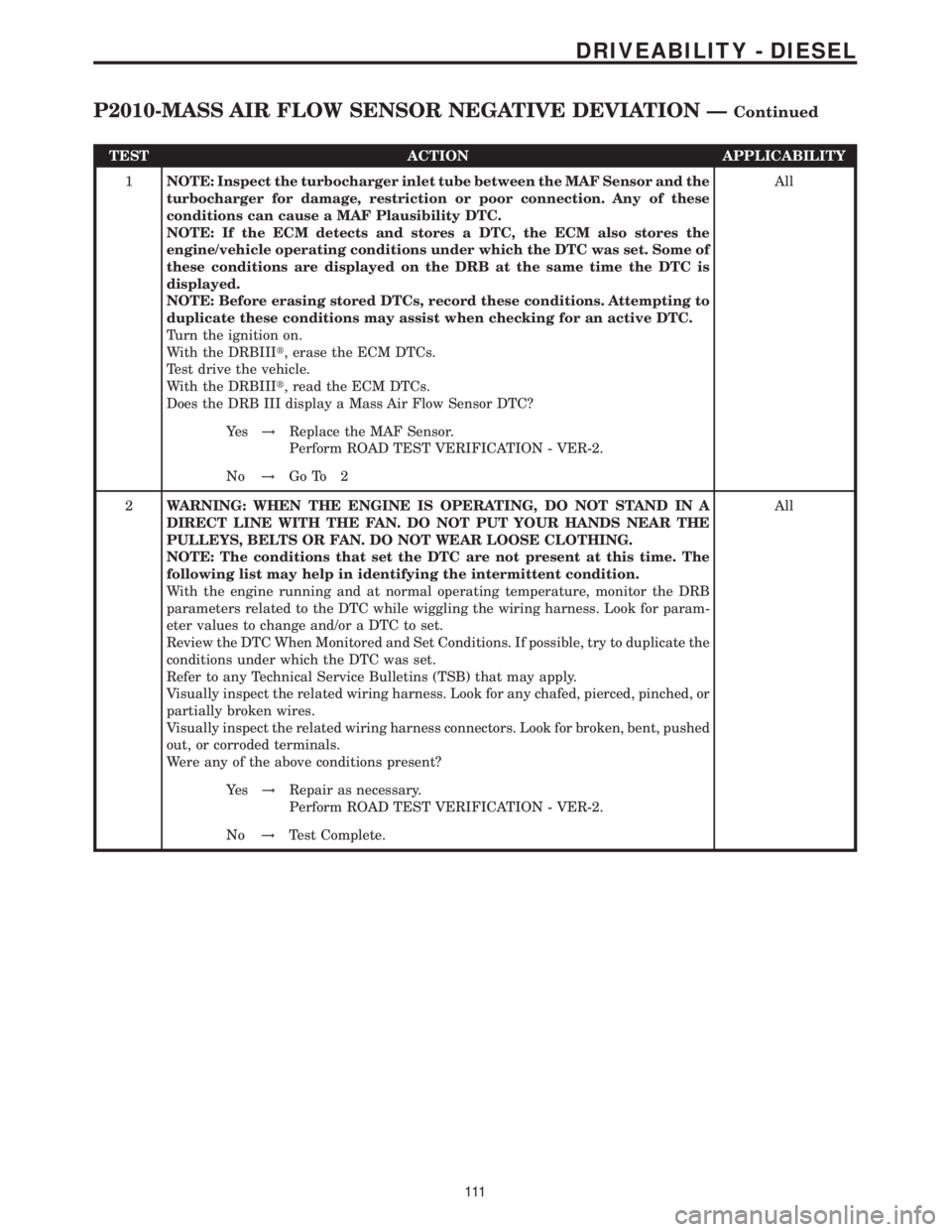
TEST ACTION APPLICABILITY
1NOTE: Inspect the turbocharger inlet tube between the MAF Sensor and the
turbocharger for damage, restriction or poor connection. Any of these
conditions can cause a MAF Plausibility DTC.
NOTE: If the ECM detects and stores a DTC, the ECM also stores the
engine/vehicle operating conditions under which the DTC was set. Some of
these conditions are displayed on the DRB at the same time the DTC is
displayed.
NOTE: Before erasing stored DTCs, record these conditions. Attempting to
duplicate these conditions may assist when checking for an active DTC.
Turn the ignition on.
With the DRBIIIt, erase the ECM DTCs.
Test drive the vehicle.
With the DRBIIIt, read the ECM DTCs.
Does the DRB III display a Mass Air Flow Sensor DTC?All
Ye s!Replace the MAF Sensor.
Perform ROAD TEST VERIFICATION - VER-2.
No!Go To 2
2WARNING: WHEN THE ENGINE IS OPERATING, DO NOT STAND IN A
DIRECT LINE WITH THE FAN. DO NOT PUT YOUR HANDS NEAR THE
PULLEYS, BELTS OR FAN. DO NOT WEAR LOOSE CLOTHING.
NOTE: The conditions that set the DTC are not present at this time. The
following list may help in identifying the intermittent condition.
With the engine running and at normal operating temperature, monitor the DRB
parameters related to the DTC while wiggling the wiring harness. Look for param-
eter values to change and/or a DTC to set.
Review the DTC When Monitored and Set Conditions. If possible, try to duplicate the
conditions under which the DTC was set.
Refer to any Technical Service Bulletins (TSB) that may apply.
Visually inspect the related wiring harness. Look for any chafed, pierced, pinched, or
partially broken wires.
Visually inspect the related wiring harness connectors. Look for broken, bent, pushed
out, or corroded terminals.
Were any of the above conditions present?All
Ye s!Repair as necessary.
Perform ROAD TEST VERIFICATION - VER-2.
No!Test Complete.
111
DRIVEABILITY - DIESEL
P2010-MASS AIR FLOW SENSOR NEGATIVE DEVIATION ÐContinued
Page 535 of 2305

Symptom List:
P2013-AMBIENT AIR TEMPERATURE SIGNAL VOLTAGE TOO
HIGH
P2013-AMBIENT AIR TEMPERATURE SIGNAL VOLTAGE TOO LOW
Test Note: All symptoms listed above are diagnosed using the same tests.
The title for the tests will be P2013-AMBIENT AIR TEMPER-
ATURE SIGNAL VOLTAGE TOO HIGH.
When Monitored and Set Condition:
P2013-AMBIENT AIR TEMPERATURE SIGNAL VOLTAGE TOO HIGH
When Monitored: With the ignition on.
Set Condition: The Ambient Air Temperature Sensor signal is above 4.82 volts.
P2013-AMBIENT AIR TEMPERATURE SIGNAL VOLTAGE TOO LOW
When Monitored: With the ignition on.
Set Condition: The Ambient Air Temperature Sensor signal is below 0.068 volt.
TEST ACTION APPLICABILITY
1NOTE: The Ambient Air Temperature Sensor is hardwired to the Instrument
Cluster
NOTE: Refer to the Instrument Cluster Diagnostic Information for the
related symptom(s).
Test Complete.All
Ye s!Test Complete.
11 2
DRIVEABILITY - DIESEL
Page 536 of 2305
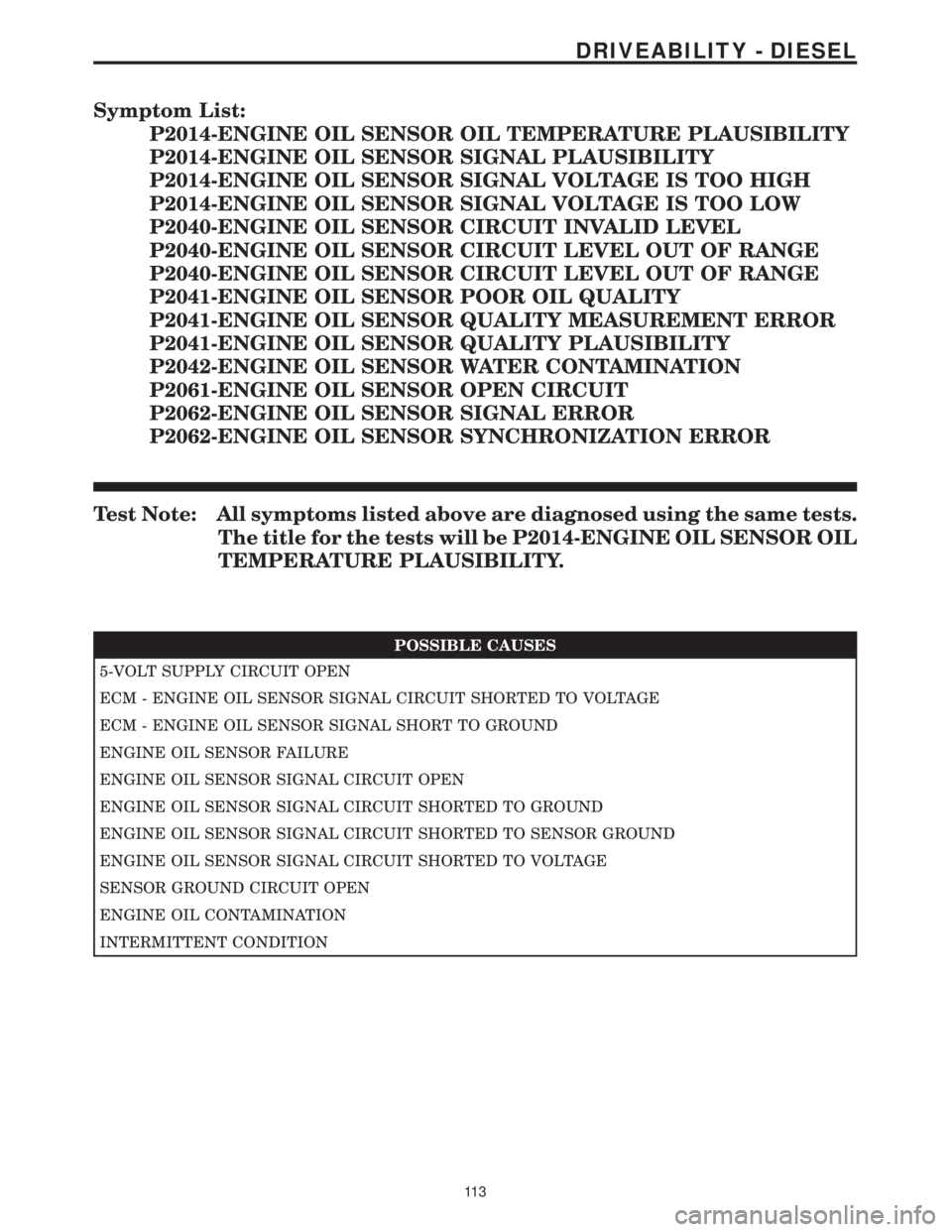
Symptom List:
P2014-ENGINE OIL SENSOR OIL TEMPERATURE PLAUSIBILITY
P2014-ENGINE OIL SENSOR SIGNAL PLAUSIBILITY
P2014-ENGINE OIL SENSOR SIGNAL VOLTAGE IS TOO HIGH
P2014-ENGINE OIL SENSOR SIGNAL VOLTAGE IS TOO LOW
P2040-ENGINE OIL SENSOR CIRCUIT INVALID LEVEL
P2040-ENGINE OIL SENSOR CIRCUIT LEVEL OUT OF RANGE
P2040-ENGINE OIL SENSOR CIRCUIT LEVEL OUT OF RANGE
P2041-ENGINE OIL SENSOR POOR OIL QUALITY
P2041-ENGINE OIL SENSOR QUALITY MEASUREMENT ERROR
P2041-ENGINE OIL SENSOR QUALITY PLAUSIBILITY
P2042-ENGINE OIL SENSOR WATER CONTAMINATION
P2061-ENGINE OIL SENSOR OPEN CIRCUIT
P2062-ENGINE OIL SENSOR SIGNAL ERROR
P2062-ENGINE OIL SENSOR SYNCHRONIZATION ERROR
Test Note: All symptoms listed above are diagnosed using the same tests.
The title for the tests will be P2014-ENGINE OIL SENSOR OIL
TEMPERATURE PLAUSIBILITY.
POSSIBLE CAUSES
5-VOLT SUPPLY CIRCUIT OPEN
ECM - ENGINE OIL SENSOR SIGNAL CIRCUIT SHORTED TO VOLTAGE
ECM - ENGINE OIL SENSOR SIGNAL SHORT TO GROUND
ENGINE OIL SENSOR FAILURE
ENGINE OIL SENSOR SIGNAL CIRCUIT OPEN
ENGINE OIL SENSOR SIGNAL CIRCUIT SHORTED TO GROUND
ENGINE OIL SENSOR SIGNAL CIRCUIT SHORTED TO SENSOR GROUND
ENGINE OIL SENSOR SIGNAL CIRCUIT SHORTED TO VOLTAGE
SENSOR GROUND CIRCUIT OPEN
ENGINE OIL CONTAMINATION
INTERMITTENT CONDITION
11 3
DRIVEABILITY - DIESEL
Page 537 of 2305

TEST ACTION APPLICABILITY
1NOTE: If DTC P1611, P2306 or P2332 is present with this DTC, diagnose
DTCs P1611, P2306 or P2332 before diagnosing this DTC.
NOTE: If the ECM detects and stores a DTC, the ECM also stores the
engine/vehicle operating conditions under which the DTC was set. Some of
these conditions are displayed on the DRB at the same time the DTC is
displayed.
NOTE: Before erasing stored DTCs, record these conditions. Attempting to
duplicate these conditions may assist when checking for an active DTC.
NOTE: The engine oil must be at the proper level for this test to be valid.
Refer to the Service Information and ensure the engine oil level is at the
specified level.
Turn the ignition on.
With the DRB, erase ECM DTCs.
Start the engine several times, letting the engine run for at least 30 seconds at a
time.
With the DRB, read ECM DTCs.
Did this DTC set again?All
Ye s!Go To 2
No!Go To 10
2WARNING: WHEN THE ENGINE IS OPERATING, DO NOT STAND IN A
DIRECT LINE WITH THE FAN. DO NOT PUT YOUR HANDS NEAR THE
PULLEYS, BELTS OR FAN. DO NOT WEAR LOOSE CLOTHING.
Refer to any Technical Service Bulletins (TSB) that may apply.
Turn the ignition off.
NOTE: This DTC implies that the engine may be contaminated by water,
engine coolant or other material due to a mechanical or service failures
such as failed gaskets, seals, cracks or incorrectly installed components.
Inspect the engine for conditions referred to in the above note.
Were any of the above conditions present?All
Ye s!Repair as necessary.
Perform ROAD TEST VERIFICATION - VER-2.
No!Go To 3
3 Turn the ignition off.
Disconnect the Engine Oil Sensor harness connector.
Turn the ignition on.
Measure the voltage of the Engine Oil Sensor Signal circuit.
Select the appropriate voltage reading.All
Voltage is above 5.4 volts.
Go To 4
Voltage is between 4.7 and 5.4 volts.
Go To 5
Voltage is below 4.7 volts.
Go To 7
11 4
DRIVEABILITY - DIESEL
P2014-ENGINE OIL SENSOR OIL TEMPERATURE PLAUSIBILITY Ð
Continued
Page 538 of 2305
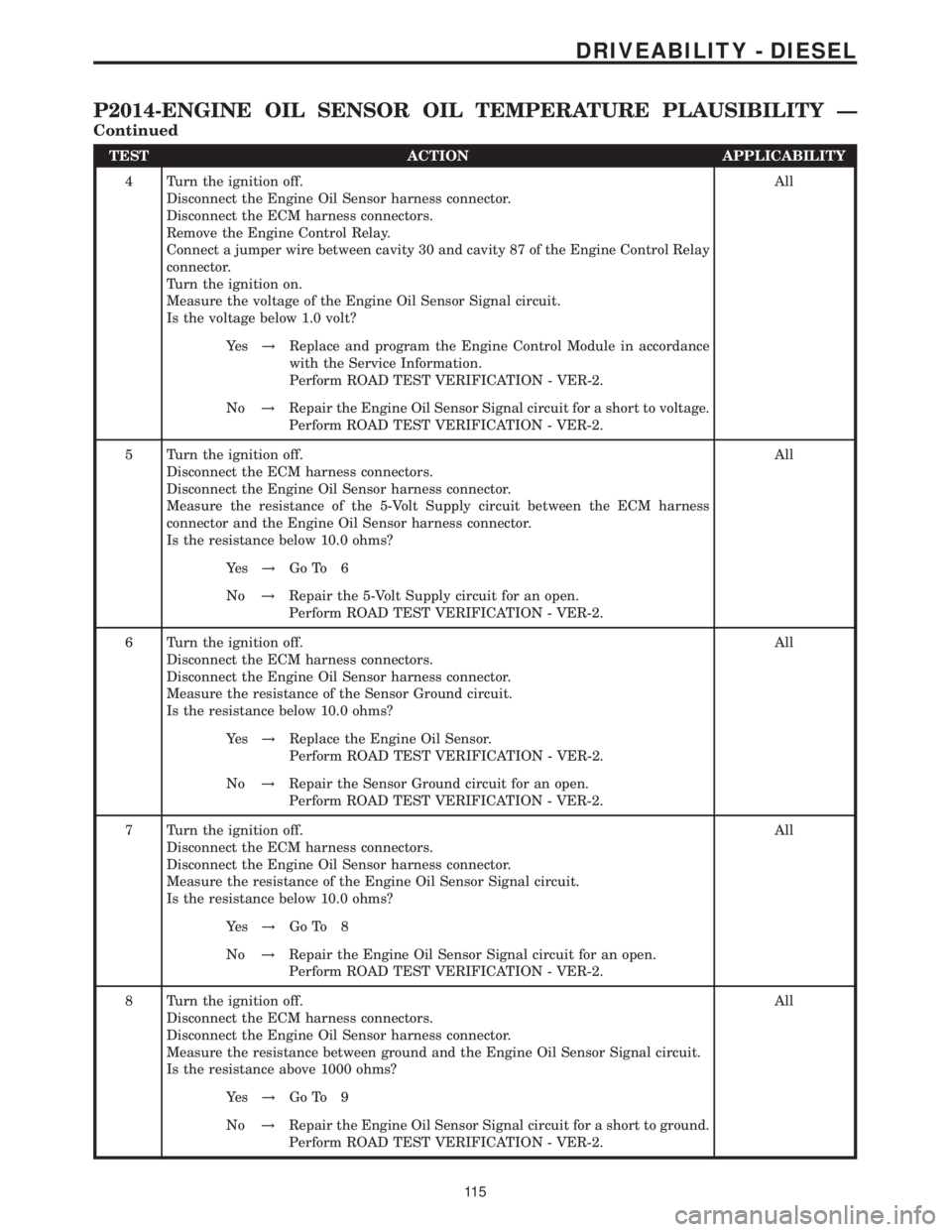
TEST ACTION APPLICABILITY
4 Turn the ignition off.
Disconnect the Engine Oil Sensor harness connector.
Disconnect the ECM harness connectors.
Remove the Engine Control Relay.
Connect a jumper wire between cavity 30 and cavity 87 of the Engine Control Relay
connector.
Turn the ignition on.
Measure the voltage of the Engine Oil Sensor Signal circuit.
Is the voltage below 1.0 volt?All
Ye s!Replace and program the Engine Control Module in accordance
with the Service Information.
Perform ROAD TEST VERIFICATION - VER-2.
No!Repair the Engine Oil Sensor Signal circuit for a short to voltage.
Perform ROAD TEST VERIFICATION - VER-2.
5 Turn the ignition off.
Disconnect the ECM harness connectors.
Disconnect the Engine Oil Sensor harness connector.
Measure the resistance of the 5-Volt Supply circuit between the ECM harness
connector and the Engine Oil Sensor harness connector.
Is the resistance below 10.0 ohms?All
Ye s!Go To 6
No!Repair the 5-Volt Supply circuit for an open.
Perform ROAD TEST VERIFICATION - VER-2.
6 Turn the ignition off.
Disconnect the ECM harness connectors.
Disconnect the Engine Oil Sensor harness connector.
Measure the resistance of the Sensor Ground circuit.
Is the resistance below 10.0 ohms?All
Ye s!Replace the Engine Oil Sensor.
Perform ROAD TEST VERIFICATION - VER-2.
No!Repair the Sensor Ground circuit for an open.
Perform ROAD TEST VERIFICATION - VER-2.
7 Turn the ignition off.
Disconnect the ECM harness connectors.
Disconnect the Engine Oil Sensor harness connector.
Measure the resistance of the Engine Oil Sensor Signal circuit.
Is the resistance below 10.0 ohms?All
Ye s!Go To 8
No!Repair the Engine Oil Sensor Signal circuit for an open.
Perform ROAD TEST VERIFICATION - VER-2.
8 Turn the ignition off.
Disconnect the ECM harness connectors.
Disconnect the Engine Oil Sensor harness connector.
Measure the resistance between ground and the Engine Oil Sensor Signal circuit.
Is the resistance above 1000 ohms?All
Ye s!Go To 9
No!Repair the Engine Oil Sensor Signal circuit for a short to ground.
Perform ROAD TEST VERIFICATION - VER-2.
11 5
DRIVEABILITY - DIESEL
P2014-ENGINE OIL SENSOR OIL TEMPERATURE PLAUSIBILITY Ð
Continued
Page 539 of 2305
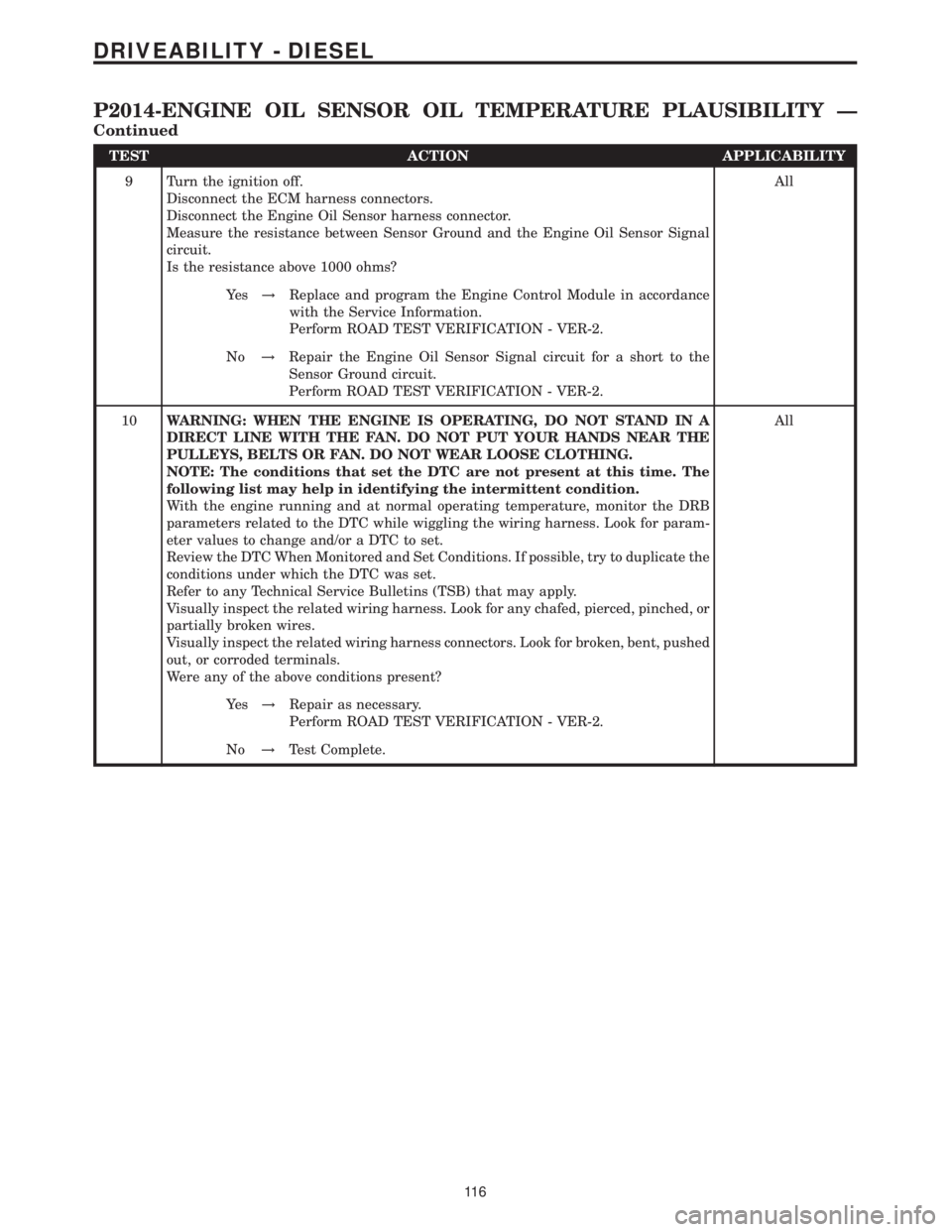
TEST ACTION APPLICABILITY
9 Turn the ignition off.
Disconnect the ECM harness connectors.
Disconnect the Engine Oil Sensor harness connector.
Measure the resistance between Sensor Ground and the Engine Oil Sensor Signal
circuit.
Is the resistance above 1000 ohms?All
Ye s!Replace and program the Engine Control Module in accordance
with the Service Information.
Perform ROAD TEST VERIFICATION - VER-2.
No!Repair the Engine Oil Sensor Signal circuit for a short to the
Sensor Ground circuit.
Perform ROAD TEST VERIFICATION - VER-2.
10WARNING: WHEN THE ENGINE IS OPERATING, DO NOT STAND IN A
DIRECT LINE WITH THE FAN. DO NOT PUT YOUR HANDS NEAR THE
PULLEYS, BELTS OR FAN. DO NOT WEAR LOOSE CLOTHING.
NOTE: The conditions that set the DTC are not present at this time. The
following list may help in identifying the intermittent condition.
With the engine running and at normal operating temperature, monitor the DRB
parameters related to the DTC while wiggling the wiring harness. Look for param-
eter values to change and/or a DTC to set.
Review the DTC When Monitored and Set Conditions. If possible, try to duplicate the
conditions under which the DTC was set.
Refer to any Technical Service Bulletins (TSB) that may apply.
Visually inspect the related wiring harness. Look for any chafed, pierced, pinched, or
partially broken wires.
Visually inspect the related wiring harness connectors. Look for broken, bent, pushed
out, or corroded terminals.
Were any of the above conditions present?All
Ye s!Repair as necessary.
Perform ROAD TEST VERIFICATION - VER-2.
No!Test Complete.
11 6
DRIVEABILITY - DIESEL
P2014-ENGINE OIL SENSOR OIL TEMPERATURE PLAUSIBILITY Ð
Continued
Page 543 of 2305
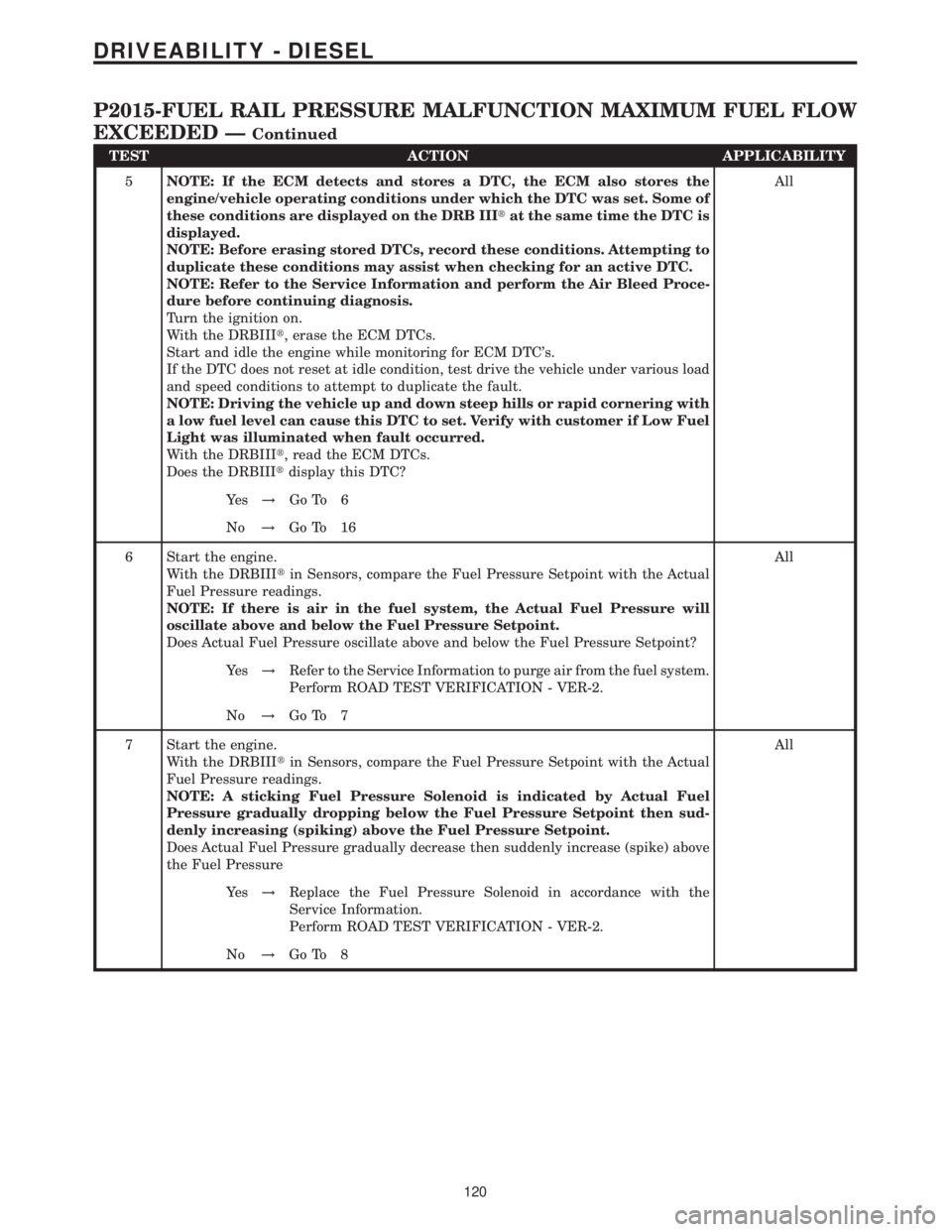
TEST ACTION APPLICABILITY
5NOTE: If the ECM detects and stores a DTC, the ECM also stores the
engine/vehicle operating conditions under which the DTC was set. Some of
these conditions are displayed on the DRB IIItat the same time the DTC is
displayed.
NOTE: Before erasing stored DTCs, record these conditions. Attempting to
duplicate these conditions may assist when checking for an active DTC.
NOTE: Refer to the Service Information and perform the Air Bleed Proce-
dure before continuing diagnosis.
Turn the ignition on.
With the DRBIIIt, erase the ECM DTCs.
Start and idle the engine while monitoring for ECM DTC's.
If the DTC does not reset at idle condition, test drive the vehicle under various load
and speed conditions to attempt to duplicate the fault.
NOTE: Driving the vehicle up and down steep hills or rapid cornering with
a low fuel level can cause this DTC to set. Verify with customer if Low Fuel
Light was illuminated when fault occurred.
With the DRBIIIt, read the ECM DTCs.
Does the DRBIIItdisplay this DTC?All
Ye s!Go To 6
No!Go To 16
6 Start the engine.
With the DRBIIItin Sensors, compare the Fuel Pressure Setpoint with the Actual
Fuel Pressure readings.
NOTE: If there is air in the fuel system, the Actual Fuel Pressure will
oscillate above and below the Fuel Pressure Setpoint.
Does Actual Fuel Pressure oscillate above and below the Fuel Pressure Setpoint?All
Ye s!Refer to the Service Information to purge air from the fuel system.
Perform ROAD TEST VERIFICATION - VER-2.
No!Go To 7
7 Start the engine.
With the DRBIIItin Sensors, compare the Fuel Pressure Setpoint with the Actual
Fuel Pressure readings.
NOTE: A sticking Fuel Pressure Solenoid is indicated by Actual Fuel
Pressure gradually dropping below the Fuel Pressure Setpoint then sud-
denly increasing (spiking) above the Fuel Pressure Setpoint.
Does Actual Fuel Pressure gradually decrease then suddenly increase (spike) above
the Fuel PressureAll
Ye s!Replace the Fuel Pressure Solenoid in accordance with the
Service Information.
Perform ROAD TEST VERIFICATION - VER-2.
No!Go To 8
120
DRIVEABILITY - DIESEL
P2015-FUEL RAIL PRESSURE MALFUNCTION MAXIMUM FUEL FLOW
EXCEEDED Ð
Continued
Page 544 of 2305

TEST ACTION APPLICABILITY
8 Refer to the appropriate Service Information and refer to Diagnosis and Testing Fuel
Delivery System table.
NOTE: The following is a list of problems that can cause fuel pressure to
deviate from specification: restricted fuel filter or fuel lines, failed fuel
pressure solenoid, failed fuel lift pump, failed fuel sending unit, contami-
nated fuel, faulty injector.
Were there any problems with the Fuel Delivery System?All
Ye s!Repair as necessary in accordance with the Service Information.
Perform ROAD TEST VERIFICATION - VER-2.
No!Go To 9
9 Refer to each of the following symptoms in the Driveability category.
CHECKING THE FUEL PRESSURE SOLENOID CIRCUITS
CHECKING THE FUEL QUANTITY SOLENOID CIRCUITS
CHECKING THE FUEL PRESSURE SENSOR CIRCUITS
Were any problems found?All
Ye s!Repair as necessary.
Perform ROAD TEST VERIFICATION - VER-2.
No!Go To 10
10NOTE: An injector that sticks open can cause this DTC. A sticking injector
will cause the engine to misfire and emit excessive black smoke from the
exhaust system.
Refer to the Service Information and perform the Fuel Injector Leak Quantity Test.
Were any problems found?All
Ye s!Using the Service Information, remove and inspect the Fuel
Injectors for signs of damage or debris that may cause the injector
to stick. Sticking injectors may cause the combustion chamber to
become black and oil soaked. Replace Injector(s) as necessary.
Perform ROAD TEST VERIFICATION - VER-2.
No!Go To 11
11 With the DRBIIIt, select System Test, Smooth Eng Run Check, then Correction
Quantity Check.
Perform this test at Idle, 2000 rpm and 3000 rpm.
NOTE: Readings per cylinder should be below 0.00450 mm
3/stroke for each
cylinder at each engine speed.
Did any of the cylinders exceed 0.00450 mm
3/stroke during this test?All
Ye s!Replace Fuel Injector of the cylinder(s) that had readings above
0.00450 mm
3/stroke.
Perform ROAD TEST VERIFICATION - VER-2.
No!Go To 12
12 With the DRBIIIt, select System Test, Smooth Eng Run Check, then Cylinder Speed
Check.
NOTE: Readings for all cylinders should be close to each other. Look for one
or two cylinders to differ high or low from the other cylinders.
Did any of the cylinders differ significantly from the majority of the other cylinders?All
Ye s!Replace Fuel Injector of the cylinder(s) that had readings signif-
icantly above or below the other fuel injectors.
Perform ROAD TEST VERIFICATION - VER-2.
No!Go To 13
121
DRIVEABILITY - DIESEL
P2015-FUEL RAIL PRESSURE MALFUNCTION MAXIMUM FUEL FLOW
EXCEEDED Ð
Continued